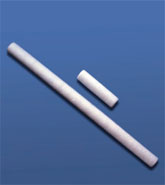The PhaseSep® A/S Series coalescer is the latest member of Pall’s PhaseSep coalescer family and is a high-efficiency phase separation element. The PhaseSep A/S coalescer can help achieve critical separations at a lower cost, with better efficiencies and reduced process times than conventional centrifuges, settlers or coalescers.
The presence of difficult to separate emulsions can be costly and problematic for fluid processing industries. Inefficient separations of liquid contaminants can cause:
- Final products to be off-specification
- Excess consumption of expensive resins or increase in wash water volumes used for purification or washing
- Costly processing delays
- Increased costs for wastewater treatment or disposal
Breaking stable emulsions can be a difficult task depending upon the process conditions. Pall has developed a highly efficient series of coalescing elements to enable separation of stable emulsions.
Important parameters in determining the ease of separating emulsions include: the interfacial tension (IFT), difference in density and viscosity. The IFT is a good way to assess the stability of an emulsion. For very stable emulsions, the IFT can be very low (‹20 dyne/cm) and conventional separation technologies, including fuel product coalescers, can lose their efficiency when the IFT reaches below 20 dyne/cm.
Typical Separation Applications
- Glycerin or glycerol from methyl ester
- Soap and water from washed BioDiesel
- Free fatty acid or methyl ester from crude glycerin
- Methyl ester from wash or wastewater
- Oil from produced water
- Organics from aqueous chemicals
Note: each application for the PhaseSep A/S Series L/L coalescer should be reviewed by Pall Corporation for technical feasibility.
Materials of Construction
| Core: | 316L stainless steel |
| Medium: | Proprietary polymer |
PhaseSep A/S Series Coalescers
- Typically remove free phase liquid contamination to a level of 50-350 ppmw based on gravimetric analysis
- Handle inlet dispersed liquid contaminant concentrations as high as 10% and greater1
- Separate emulsions with interfacial tensions as low as 0.5 dyne/cm
Performance Claims
| Maximum temperature:2 | 250°F (121°C) |
| Recommended change-out: | 15 psid (1.03 bard) |
| Maximum differential pressure rating: | 30 psid (2.07 bard) @ 100°F (37.8°C) |
| Initial pressure drop for typical applications:3 | |
1 For applications greater than 2% dispersed liquid, the PhaseSep A/S Series horizontal housing will utilize two collection boots.
2 Maximum temperature is 250°F (121°C) for most fluids, excluding strong acids. Pall suggests soak testing at higher temperatures. Note: element burst has not been evaluated for temperatures higher than 100°F (37°C).
3 Typically ‹2 psid for most applications. Can be higher due to increased viscosity or flow rate.
Compatibility
Compatibility is also a key consideration when selecting a coalescer. Pall coalescers are available in a wide range of materials including various polymers and fluoropolymers.
PhaseSep A/S Coalescer Compatibility Guide with Fluids at 250°F (121°C)
| Chemical Classification | Examples | Rating |
| Inorganic Acids | Hydrochloric, Dilute Nitric, Dilute Sulfuric Boric, Phosphoric | NR GR |
| Organic Acids | Acetic Formic | GR T |
| Bases (Alkalis) | Sodium Hydroxide, Potassium Hydroxide, Amines, Quaternary Ammonium Hydroxide | GR GR |
| Salt Solutions | Aluminum Chloride, Sodium Sulfide, Sodium Nitrate | T T |
| Brines | Sodium Chloride, Potassium Chloride, Sodium Bromide, Calcium Chloride Aqueous Halogenated Solutions | GR GR NR |
| Oxidizers | Peroxides, Peracids | NR |
| Organic Solvents | Ethers, Esters, Amides, Ketones Alcohols, Cellsolves, Glycols Aromatics (Benzene, Toulenes, Xylenes) Petroleum Products (Gasoline, Kerosene) Hydrocarbons (Hexane, Octane, Fats, Oils, Petroleum Ether) Halogenated Hydrocarbons (Methylene Chloride, Perchloroethylene) | GR GR T GR GR GR T T |
| Water Air | GR GR | |
GR = Generally Recommended NR = Not Recommended T = Evaluate on an Individual Basis
LCS • FPS ■ 00 (e.g. LCS1FPS200)
Code • | Length (nominal) inches /mm |
| 1 | 10 / 254 |
| 4 | 40 / 1016 |
| Code ■ | Removal Ratings |
| 1 | Fine |
| 2 | Medium |
| 4 | Coarse |
Earn 10% off* your next order online by leaving a review of this product. Please login to your account to leave a review. We appreciate and value your feedback.
*Subject to Terms and Conditions.



